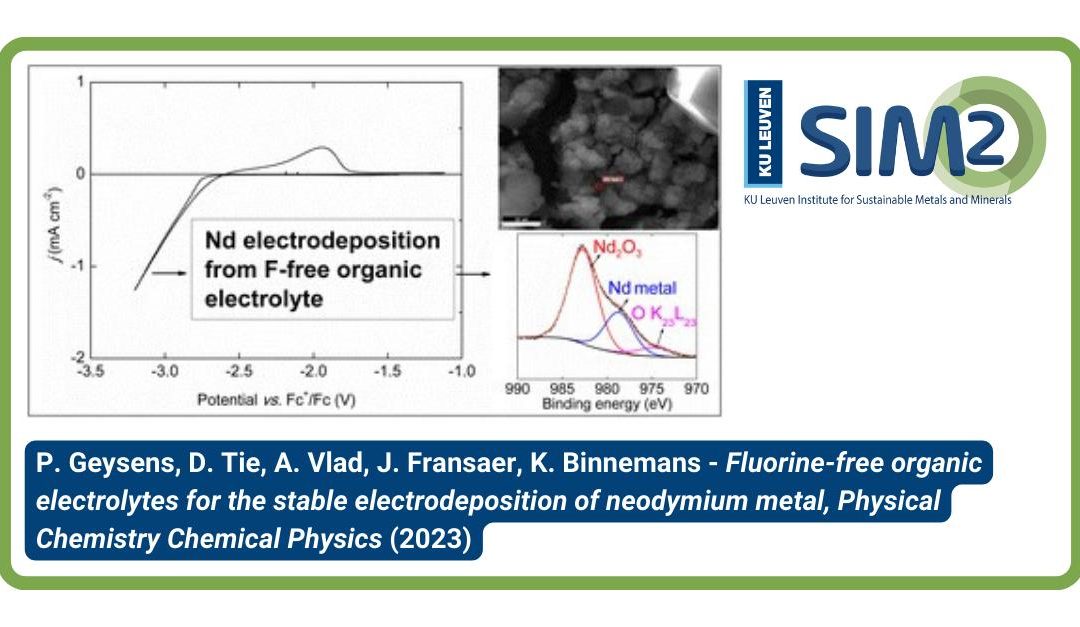The rare-earth element neodymium, which is becoming increasingly important for the green energy transition, was successfully electrodeposited at ambient temperatures from fluorine-free organic electrolytes. The electrolytes consist of a redox-active neodymium borohydride complex, dissolved in an ether solvent. Contrary to the fluorine-containing electrolytes in our previous work, electrodeposition proceeded with a constant current density, because no passivation of the reactive deposits occurred. Elemental analysis confirmed the high content of neodymium in the deposits and X-ray photoelectron spectroscopy analysis confirmed that it is partially in the metallic form.
Electrowinning of REEs
Electrowinning is widely regarded as a clean method for the recovery of elements in the metallic form. An electric current is used for the reduction of the metal ions, as opposed to a chemical reducing agent which imposes additional costs and generates waste products. However, the highly reactive and strongly reducing nature of metallic REEs imposes many constraints on the type of electrolytes that can be used for this purpose. Currently, the state-of-the-art technology for REE electrowinning are molten salt electrolytes, which have a very high operating temperature (energy-intensive) and are corrosive to the infrastructure. The ionic liquid technology has been explored as an alternative with lower operating temperatures, but the high cost of the electrolytes severely limits the possibility for upscaling. Furthermore, the often fluorinated anions are very persistent in the environment (e.g. PFAS).
Previous work on organic electrolytes for room-temperature electrodeposition of REEs
Previously, our group has explored organic electrolytes for the room temperature electrodeposition of the REEs neodymium and dysprosium. The electrolytes consisted of a soluble REE salt, Ln(Tf2N)3 (Tf2N = bis(trifluoromethylsulfonyl)imide, bistriflimide), and four molar equivalents of a commercially available borohydride salt, NaBH4, LiBH4, TBABH4 (TBA = tetra-n-butylammonium), dissolved in an ether solvent. This resulted in the formation of a redox-active anionic borohydride complex with the general structure [Ln(BH4)4]-. While it was possible to deposit neodymium and dysprosium in the metallic form from these electrolytes, we also found that the fluorinated bistriflimide anion reacted with the strongly reducing deposits, resulting in the formation of non-conductive (passivating) surface films and a subsequent fast decrease in current density during electrodeposition. This is one of several reasons that the use of this anion should be avoided altogether.
New fluorine-free electrolytes
By substituting the bistriflimide salt for a chloride salt (NdCl3), or a methansulfonate salt (Nd(OMs)3), we developed new fluorine-free organic electrolytes for the room-temperature electrodeposition of neodymium metal. The same metathesis reaction occurs, resulting in the formation of the redox-active complex [Ln(BH4)4]-, but this time without any fluorinated anions left in solution. This complex can be isolated from solution and be used as a convenient salt to prepare organic electrolytes in ether solvents (tetrahydrofuran and glymes). Because the electrolytes don’t contain the reactive bistriflimide anion, the formation of passivating surface films is avoided and potentiostatic electrodeposition proceeds without a significant loss of current density. Chronoamperometry experiments resulted in black deposits that were sensitive to oxidation. Energy-dispersive X-ray (EDX) analysis of the deposits confirmed that neodymium was the main component (up to 75 atomic%), and X-ray photoelectron spectroscopy (XPS) of fresh deposits gave evidence that the lanthanides were partially in the metallic form (approximately 50%).
Electrolytes for low-temperature electrowinning of neodymium and other REEs currently primarily consist of ionic liquids with expensive and environmentally persistent fluorinated anions. We are convinced that this fluorine-free organic borohydride-based system is an important step forward in the right direction, and that it can still be improved upon.
Full reference paper
P. Geysens, D. Tie, A. Vlad, J. Fransaer, K. Binnemans, Fluorine-free organic electrolytes for the stable electrodeposition of neodymium metal, Phys. Chem. Chem. Phys., 2023, 25, 21397 – 21407, DOI: 10.1039/D3CP01262J.
Acknowledgements
This project (EOS 40007515) has received funding from the FWO and F.R.S.-FNRS under the Excellence of Science (EOS) programme.

